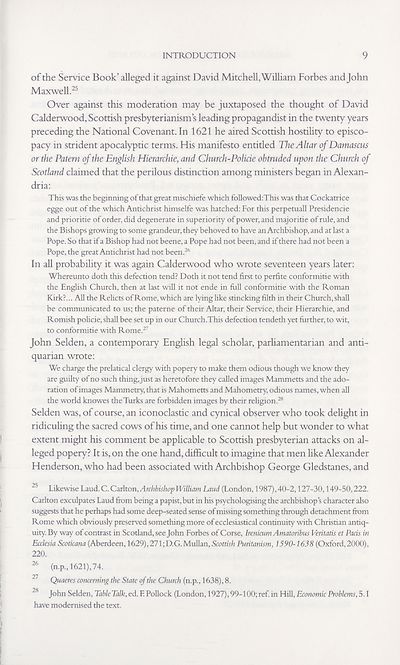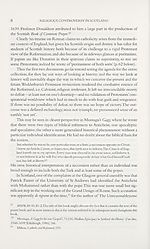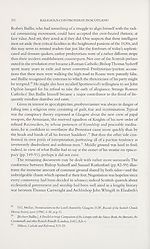Series 5 > Religious Controversy in Scotland 1625-1639
(24) Page 9
Download files
Complete book:
Individual page:
Thumbnail gallery: Grid view | List view

INTRODUCTION
9
of the Service Book’ alleged it against David Mitchell, William Forbes and John
Maxwell.25
Over against this moderation may be juxtaposed the thought of David
Calderwood, Scottish presbyterianism’s leading propagandist in the twenty years
preceding the National Covenant. In 1621 he aired Scottish hostility to episco¬
pacy in strident apocalyptic terms. His manifesto entitled The Altar of Damascus
or the Patern of the English Hierarchie, and Church-Policie obtruded upon the Church of
Scotland claimed that the perilous distinction among ministers began in Alexan¬
dria:
This was the beginning of that great mischiefe which followed:This was that Cockatrice
egge out of the which Antichrist himselfe was hatched: For this perpetuall Presidencie
and prioritie of order, did degenerate in superiority of power, and majoritie of rule, and
the Bishops growing to some grandeur, they behoved to have an Archbishop, and at last a
Pope. So that if a Bishop had not beene, a Pope had not been, and if there had not been a
Pope, the great Antichrist had not been.26
In all probability it was again Calderwood who wrote seventeen years later:
Whereunto doth this defection tend? Doth it not tend first to perfite conformitie with
the English Church, then at last will it not ende in full conformitie with the Roman
Kirk?... All the Relicts of Rome, which are lying like stincking filth in their Church, shall
be communicated to us; the paterne of their Altar, their Service, their Hierarchie, and
Romish policie, shall bee set up in our Church.This defection tendeth yet further, to wit,
to conformitie with Rome.27
John Selden, a contemporary English legal scholar, parliamentarian and anti¬
quarian wrote:
We charge the prelatical clergy with popery to make them odious though we know they
are guilty of no such thing,] ust as heretofore they called images Mammetts and the ado¬
ration of images Mammetry, that is Mahometts and Mahometry, odious names, when all
the world knowes the Turks are forbidden images by their religion.28
Selden was, of course, an iconoclastic and cynical observer who took delight in
ridiculing the sacred cows of his time, and one cannot help but wonder to what
extent might his comment be applicable to Scottish presbyterian attacks on al¬
leged popery? It is, on the one hand, difficult to imagine that men hke Alexander
Henderson, who had been associated with Archbishop George Gledstanes, and
25 Likewise Laud. C. Carlton, Archbishop William Laud (London, 1987), 40-2,127-30,149-50,222.
Carlton exculpates Laud from being a papist, but in his psychologising the archbishop’s character also
suggests that he perhaps had some deep-seated sense of missing something through detachment from
Rome which obviously preserved something more of ecclesiastical continuity with Christian antiq¬
uity. By way of contrast in Scotland, see John Forbes of Corse, Irenicum Amatoribus Veritatis et Pacts in
Ecclesia Scoticana (Aberdeen, 1629), 271; D.G. Mullan, Scottish Puritanism, 1590-1638 (Oxford, 2000),
220.
26 (n.p., 1621), 74.
27 Quaeres concerning the State of the Church (n.p., 1638), 8.
28 John Selden, Table Talk, ed. F. Pollock (London, 1927), 99-100; ref. in Hill, Economic Problems, 5.1
have modernised the text.
9
of the Service Book’ alleged it against David Mitchell, William Forbes and John
Maxwell.25
Over against this moderation may be juxtaposed the thought of David
Calderwood, Scottish presbyterianism’s leading propagandist in the twenty years
preceding the National Covenant. In 1621 he aired Scottish hostility to episco¬
pacy in strident apocalyptic terms. His manifesto entitled The Altar of Damascus
or the Patern of the English Hierarchie, and Church-Policie obtruded upon the Church of
Scotland claimed that the perilous distinction among ministers began in Alexan¬
dria:
This was the beginning of that great mischiefe which followed:This was that Cockatrice
egge out of the which Antichrist himselfe was hatched: For this perpetuall Presidencie
and prioritie of order, did degenerate in superiority of power, and majoritie of rule, and
the Bishops growing to some grandeur, they behoved to have an Archbishop, and at last a
Pope. So that if a Bishop had not beene, a Pope had not been, and if there had not been a
Pope, the great Antichrist had not been.26
In all probability it was again Calderwood who wrote seventeen years later:
Whereunto doth this defection tend? Doth it not tend first to perfite conformitie with
the English Church, then at last will it not ende in full conformitie with the Roman
Kirk?... All the Relicts of Rome, which are lying like stincking filth in their Church, shall
be communicated to us; the paterne of their Altar, their Service, their Hierarchie, and
Romish policie, shall bee set up in our Church.This defection tendeth yet further, to wit,
to conformitie with Rome.27
John Selden, a contemporary English legal scholar, parliamentarian and anti¬
quarian wrote:
We charge the prelatical clergy with popery to make them odious though we know they
are guilty of no such thing,] ust as heretofore they called images Mammetts and the ado¬
ration of images Mammetry, that is Mahometts and Mahometry, odious names, when all
the world knowes the Turks are forbidden images by their religion.28
Selden was, of course, an iconoclastic and cynical observer who took delight in
ridiculing the sacred cows of his time, and one cannot help but wonder to what
extent might his comment be applicable to Scottish presbyterian attacks on al¬
leged popery? It is, on the one hand, difficult to imagine that men hke Alexander
Henderson, who had been associated with Archbishop George Gledstanes, and
25 Likewise Laud. C. Carlton, Archbishop William Laud (London, 1987), 40-2,127-30,149-50,222.
Carlton exculpates Laud from being a papist, but in his psychologising the archbishop’s character also
suggests that he perhaps had some deep-seated sense of missing something through detachment from
Rome which obviously preserved something more of ecclesiastical continuity with Christian antiq¬
uity. By way of contrast in Scotland, see John Forbes of Corse, Irenicum Amatoribus Veritatis et Pacts in
Ecclesia Scoticana (Aberdeen, 1629), 271; D.G. Mullan, Scottish Puritanism, 1590-1638 (Oxford, 2000),
220.
26 (n.p., 1621), 74.
27 Quaeres concerning the State of the Church (n.p., 1638), 8.
28 John Selden, Table Talk, ed. F. Pollock (London, 1927), 99-100; ref. in Hill, Economic Problems, 5.1
have modernised the text.
Set display mode to:
![]() Universal Viewer |
Universal Viewer | ![]() Mirador |
Large image | Transcription
Mirador |
Large image | Transcription
Images and transcriptions on this page, including medium image downloads, may be used under the Creative Commons Attribution 4.0 International Licence unless otherwise stated. ![]()
| Scottish History Society volumes > Series 5 > Religious Controversy in Scotland 1625-1639 > (24) Page 9 |
|---|
| Permanent URL | https://digital.nls.uk/127328253 |
|---|
| Description | Over 180 volumes, published by the Scottish History Society, containing original sources on Scotland's history and people. With a wide range of subjects, the books collectively cover all periods from the 12th to 20th centuries, and reflect changing trends in Scottish history. Sources are accompanied by scholarly interpretation, references and bibliographies. Volumes are usually published annually, and more digitised volumes will be added as they become available. |
|---|


